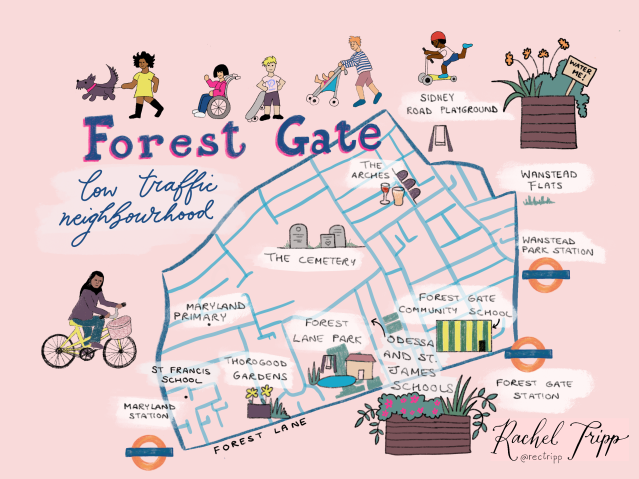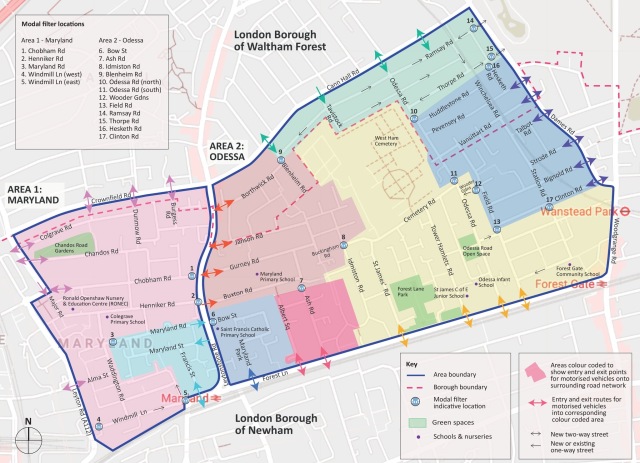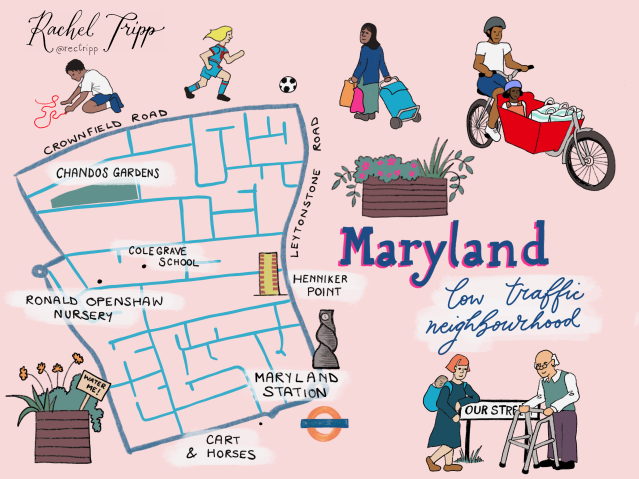 I am actually writing this post after the bollards and planters have started to be installed, but nevertheless wanted to mark the occasion by saying that we now have Newham’s first (and I believe the first ever cross-borough) low traffic neighbourhood.
I am actually writing this post after the bollards and planters have started to be installed, but nevertheless wanted to mark the occasion by saying that we now have Newham’s first (and I believe the first ever cross-borough) low traffic neighbourhood.
If that term isn’t familiar to you, then please do read my previous post, which goes through the concept, and gives some background, some examples, and what the benefits can be:
All about low traffic neighbourhoods
The design of this LTN is on this map below. I confess it took me a little whilst to properly understand it, and in fact after a couple of questions on social media, it was updated to make it more clear. In essence, the filters have been designed and placed so that if you need to travel by car, you can drive within each of the coloured areas, but to go between them you need to travel to the main road and drive around.
I am sure I’ll be blogging about this much more in the future, (lucky you) but I did want to take the time to discuss a couple of things here.
All roads are still accessible
Firstly to make it clear that no road is inaccessible (or it shouldn’t be! Our project manager has spent some considerable time examining the various routes through). If you live in this area, and you have a car, and you are making a journey that you need to drive, then you can still drive to and from your house. Equally, visitors can drive to you, as can deliveries, emergency service vehicles (more on that later) and more.
Of course, you might have to take a slightly different route. Your quickest way to a main road may now be closed to cars, so you may have to divert in order to use one of the entry and exit points (marked on the map above by the small double-headed arrows). This is a necessary feature of an LTN.
But there are a few points to make about this. Firstly that if you are travelling a long way, this additional time is likely to be a very small proportion of your overall journey. If you are making a shorter journey then the additional time will help those people who can move to a different form of travel to do so, whilst those people who still need to use their vehicles can.
Filters, not closures
This might sound pedantic, but it’s an important point. We (and I include myself in this) often talk about through-traffic reduction as being made up of ‘road closures’. Actually, the roads all remain open to people walking, scooting, wheeling in wheelchairs or mobility scooters, cycling, playing, running or indeed cartwheeling or playing football. Motor vehicles can access the road but cannot drive through it on their way somewhere else. A term that transport planners use which used to mystify me as well is ‘modal filters’, which are so-called because they are a ‘filter’, not a closure. People can pass through. Most cars cannot. Which brings me onto…
Why not cameras?
This is an interesting question. Some residents cite the Browning Road bridge as an example of the kind of ‘closure’ they would like to see: marked as closed to through-traffic with a camera to catch offenders, and exemptions for local residents. And I can see the attractiveness of these, partly because we’re already accustomed to them with the healthy school streets. Another benefit of cameras is that they raise money. I remember two years ago sitting in a cafe in another borough by a camera-enforced pedestrian street that a local councillor told me raised one MILLION pounds per year. That’s money that can be spent on our streets, creating more LTNs, planting trees, resurfacing roads etc, and I’d be lying if I said that wasn’t tempting.
But the reason so much money is raised is because camera enforced closures are routinely ignored, and traffic still runs through them. Most of the drivers who do so are fined, so after an initial surge of tickets, this does slow down. But it seems to be unstoppable. Footage from across London of filters in LTNs shows cars slowing, examining signs which show that there is no access, and then driving through anyway. In some cases, I’m told, driving through at higher speed in order to ‘beat’ the camera. Cars that are stolen, or not registered, cannot be easily pursued for payment.
I’m also a bit concerned about some of the logistics of exemption permits. Who gets them? Who doesn’t? There has to be a line somewhere, where one household can be exempt and the household next door is not, and whilst all of politics involves dealing with those kind of boundaries, and restrictions, I don’t necessarily welcome the idea of creating more!
But my main feeling about cameras, and the reason why they are generally used as a ‘last resort’ to achieve an LTN is that they give some of the benefits of an LTN but not all of them. They don’t reduce through-traffic to the same extent. You have a safer street, but not one where people can safely and confidently use the road space. You also, to be absolutely honest, don’t get that ‘nudge’ that a physical closure can give, and which we’ve seen elsewhere results in local people walking more, and cycling more.
Some of the most moving footage I’ve seen of LTNs elsewhere is of children learning to ride their bikes in roads that would previously have been too dangerous: wobbling and pedaling, and gaining in confidence. Children playing around bollards and planters, kicking a football or running around. Without wanting to sound mawkish, our children have had a hell of a year, without access to face to face learning, without even access to playgrounds, or friends. For some children this has been upsetting and discomforting. For our more vulnerable children, the impact has been serious. I attended a webinar on LTNs where an architect who advocates for child-friendly cities said that play, and particularly play outside on the road, play that is easily accessible from the home, in a space large enough to social distance, will be a place where a lot of the healing will happen.
Emergency services
Some residents are really worried about emergency services access, and of course the idea of people waiting longer in a potentially life or death situation is a very concerning one. That’s why the emergency services are one of our statutory consultees, and my colleagues in highways shared the draft scheme with them before it was published, and made changes to it where necessary. For example, there is a camera-controlled filter in Wooder Gardens, which I believe was initially proposed as a physical barrier but the emergency services needed access.
Something I found really interesting, and if I’m honest frankly a bit unbelievable at first, is that in Waltham Forest, where a form of LTNs have been implemented all over the borough over the past several years, emergency services response times haven’t been lengthened but have actually reduced very slightly. I now can’t find the table of times I was looking at yesterday, but I will add it to this post when I do. This issue is also discussed on the excellent ‘we love Mini Holland’ site here: https://wesupportmh.wordpress.com/myths/
What now?
Some residents have been concerned about a lack of consultation, and I do hear that. This scheme has been brought in much more quickly than I would ever have imagined, and in non-Covid times I would have loved to do all of this much more slowly, with meetings and discussions and co-design sessions and much more. But government money is available for LTNs precisely because of their importance at helping us move around safely without becoming ill. And that money quite rightly had to be used to schemes that were done fast, so that people can get back to work where possible, can get back to moving around, and living their lives. Hence, everywhere we’re seeing changes happen much faster than we’re used to: pop-up bike lanes, widened pavements, LTNs across London.
The filters have all been put in with experimental traffic orders,which we sincerely hope will be permanent, but which does mean that there is scope to improve them. I’ve already had some contact with a resident about a particular issue with parking and unloading near her home (if you’re reading this, I haven’t received your email yet! Please do message me).
I’m going to write another, separate post, about the initial ‘bedding in’ period, which I’m hoping to post today. I know there has been a lot of discussion about the LTNs on social media, some of which has been really useful and constructive, and some of which has had a range of very strongly expressed views, some helpful and some less so.
We’ll be doing a lot of talking about LTNs over the coming 6 months. Not least because we do have more coming, and we’ll need to be tweaking and working on them all to make sure we get them right, which we’ll only be able to do with your help. Do drop me a line if you have questions or if there is something you’d like to discuss. I am currently replying to emails much more slowly than I’d like, but am hopeful this will improve when (if?) the schools reopen in September. Thanks for bearing with me.





Pingback: LTNs – settling in and teething trouble | Forest Gate North – Rachel Tripp's councillor blog
Pingback: Ward report September 2020 | Forest Gate North – Rachel Tripp's councillor blog